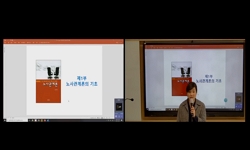The practical status of the “rules of employment” within the workplace varies greatly. The functions and roles of the rules of employment can vary depending on how the rules of employment are interpreted according to collective agreements and, or ...
http://chineseinput.net/에서 pinyin(병음)방식으로 중국어를 변환할 수 있습니다.
변환된 중국어를 복사하여 사용하시면 됩니다.
- 中文 을 입력하시려면 zhongwen을 입력하시고 space를누르시면됩니다.
- 北京 을 입력하시려면 beijing을 입력하시고 space를 누르시면 됩니다.

현행 취업규칙 제도의 기능적 한계와 개선방안 - 주요 대법원판결의 흐름을 중심으로 - = The Current Rules of Employment System's Functional Limitations and Ways to Improve the System - Focusing on the trend in major Supreme Court rulings -
한글로보기부가정보
다국어 초록 (Multilingual Abstract)
This study examines the existing discussions and issues related to the rules of employment, focusing on the Supreme Court rulings, and proposes measures to improve the direction of the system of mandating the rules of employment while addressing its functional limitations. Regarding the direction or purpose of mandating the rules of employment, the excessive emphasis on the principle of equality in decision-making between labor and management is deemed inappropriate. This is because, while there are similarities in the functions and purposes of collective agreements and the rules of employment, there are also differences. The rules of employment system is essentially a system designed to collectively regulate individual labor contract relationships and can be evaluated as being positioned in the middle ground between individual labor contracts and the collective agreement framework. From this point of view, this study proposed an improvement plan for the rules of employment.
The practical status of the “rules of employment” within the workplace varies greatly. The functions and roles of the rules of employment can vary depending on how the rules of employment are interpreted according to collective agreements and, or labor contracts. As a result, various and extensive discussions on “rules of employment” are being developed, and many meaningful and important Supreme Court rulings have been accumulated. Key issues surrounding this topic include the relationship between the rules of employment and labor contracts, the method of obtaining the collective consent on the rules of employment, the validity of unfavorable changes to the rules of employment without consent, and the Supreme Court's change in its use of the theory of rationality based on social norms. These issues have been discussed as independent topics, but it is judged that there have not been sufficient attempts to identify the nature of the rules of employment and establish it systematically. There is also a practical need to clarify the functions and roles of the rules of employment. Many employers and workers may find the existing debates on the rules of employment overly conceptual.
This study examines the existing discussions and issues related to the rules of employment, focusing on the Supreme Court rulings, and proposes measures to improve the direction of the system of mandating the rules of employment while addressing its functional limitations. Regarding the direction or purpose of mandating the rules of employment, the excessive emphasis on the principle of equality in decision-making between labor and management is deemed inappropriate. This is because, while there are similarities in the functions and purposes of collective agreements and the rules of employment, there are also differences. The rules of employment system is essentially a system designed to collectively regulate individual labor contract relationships and can be evaluated as being positioned in the middle ground between individual labor contracts and the collective agreement framework. From this point of view, this study proposed an improvement plan for the rules of employment.
동일학술지(권/호) 다른 논문
-
국가균형발전을 위한 지방자치 및 분권형 헌법개정에 대한 담론
- 원광대학교 법학연구소
- 송혜원
- 2024
- KCI등재
-
뉴질랜드의 불법 마약 관련 법과 통제정책 : 한국과의 간략한 비교
- 원광대학교 법학연구소
- Ki-Myung, Song
- 2024
- KCI등재
-
강제추행죄에 있어 폭행의 개념성에 관한 비판적 검토 -대법원 2023. 9. 21. 선고 2018도13877 전원합의체 판결을 중심으로-
- 원광대학교 법학연구소
- 강현석
- 2024
- KCI등재
-
- 원광대학교 법학연구소
- 김잔디
- 2024
- KCI등재




 KCI
KCI 스콜라
스콜라



